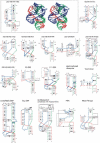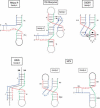Topology of three-way junctions in folded RNAs
- PMID: 16373494
- PMCID: PMC1370888
- DOI: 10.1261/rna.2208106
Topology of three-way junctions in folded RNAs
Abstract
The three-way junctions contained in X-ray structures of folded RNAs have been compiled and analyzed. Three-way junctions with two helices approximately coaxially stacked can be divided into three main families depending on the relative lengths of the segments linking the three Watson-Crick helices. Each family has topological characteristics with some conservation in the non-Watson-Crick pairs within the linking segments as well as in the types of contacts between the segments and the helices. The most populated family presents tertiary interactions between two helices as well as extensive shallow/minor groove contacts between a linking segment and the third helix. On the basis of the lengths of the linking segments, some guidelines could be deduced for choosing a topology for a three-way junction on the basis of a secondary structure. Examples and prediction bas'ed on those rules are discussed.
Figures










References
-
- Agalarov, S.C., Sridhar Prasad, G., Funke, P.M., Stout, C.D., and Williamson, J.R. 2000. Structure of the S15, S6, S18-rRNA complex: Assembly of the 30S ribosome central domain. Science 288: 107–113. - PubMed
-
- Ban, N., Nissen, P., Hansen, J., Moore, P.B., and Steitz, T.A. 2000. The complete atomic structure of the large ribosomal subunit at 2.4 Å resolution. Science 289: 905–920. - PubMed
-
- Batey, R.T., Rambo, R.P., and Doudna, J.A. 1999. Tertiary motifs in RNA structure and folding. Angew Chem. Int. Ed. Engl. 38: 2326–2343. - PubMed
MeSH terms
Substances
LinkOut - more resources
Full Text Sources
Other Literature Sources
